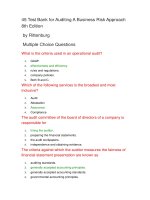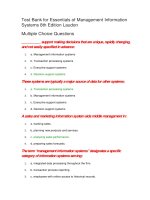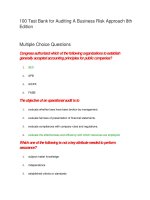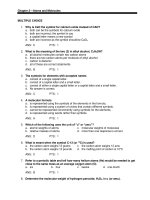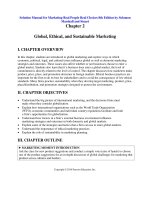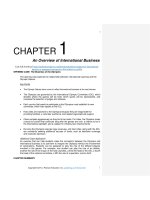Rules for writers (diana hacker nancy sommers) 8th ed
Bạn đang xem bản rút gọn của tài liệu. Xem và tải ngay bản đầy đủ của tài liệu tại đây (19.87 MB, 708 trang )
You’re a writer.
Rules for Writers is here for you.
No one learns everything about writing in a single course or
even two; we all need to consult the rules or seek out advice
sometimes. Having a reliable support system is key. Your
peers, your instructor, and your writing center are part of your
support system — and so is your Rules for Writers. Whatever the
assignment, whatever your purpose for writing, Rules for Writers
has answers and advice you need for papers and projects in
every course. The more you rely on your handbook and learn
from its advice, the more successful you’ll be as a college writer.
According to a recent survey of 700
students at 50 colleges, 79% of students
feel that their handbook makes them
more effective academic writers.
E ighth Edit ion
Rules for
WRITERS
More support for you online
If your instructor has assigned this book with LaunchPad Solo
for Rules for Writers, use the activation code to access even
more support. Visit macmillanhighered.com/rules8e to check
out 192 grammar and research exercises, 39 sample student
papers, and 30 LearningCurve adaptive quizzes.
macmillanhighered.com
Diana Hacker
Nancy Sommers
mech_HackerSommers-Rules8-SE-080715
The Writing Process
f with infinitives
g with gerunds
25 Case of who and
whom case 227
26 Adjectives and
adverbs adj/adv 230
a adjectives
b adverbs
c good, well, bad,
badly
d comparatives and
superlatives
e double negatives
27 Verb forms, tenses,
moods vb 237
a irregular verbs
b lie and lay
c -s (or -es) endings
d -ed endings
e omitted verbs
f tense
g mood
1
1 Exploring, planning, and drafting 3
2 Revising, editing, and reflecting 30
3 Building effective paragraphs 49
Academic Reading, Writing, and Speaking
4
5
6
7
Clarity
8
9
10
11
12
13
14
15
16
17
18
125
Active verbs 126
Parallel ideas 129
Needed words 133
Mixed constructions 137
Misplaced and dangling modifiers 140
Shifts 147
Emphasis 152
Variety 163
Wordy sentences 166
Appropriate language 170
Exact words 180
Grammar
19
20
21
22
23
24
25
26
27
Multilingual/ESL 255
28 Verbs ESL 256
29 Articles; types of
nouns ESL 270
30 Structure ESL 279
31 Prepositions and
idioms ESL 288
Punctuation 293
32 The comma ^, 294
187
a with and, but, etc.
b introductory
elements
c series
d coordinate
adjectives
e nonrestrictive
elements
f transitions
g direct address, yes
and no, etc.
h he said etc.
i dates, addresses,
titles, numbers
j to prevent
confusion
33 Unnecessary
commas no , 308
34 The semicolon ;
Sentence fragments 188
Run-on sentences 195
Subject-verb agreement (is or are etc.) 202
Pronoun-antecedent agreement (singular or plural) 213
Pronoun reference (clarity) 218
Pronoun case (I and me etc.) 222
who and whom 227
Adjectives and adverbs 230
Standard English verb forms, tenses, and moods 237
Multilingual Writers and ESL Challenges
28
29
30
31
65
Reading and writing critically 66
Reading and writing about multimodal texts 80
Reading and writing arguments 91
Speaking confidently 119
255
Verbs 256
Articles 270
Sentence structure 279
Prepositions and idiomatic expressions 288
Rules8_SE_IFC_IBC.indd 2
b transitional
expressions
c series
d misuses
35 The colon : 317
a with lists,
appositives,
quotations
b conventional uses
c misuses
36 The apostrophe ’
319
a possessive nouns
b indefinite
pronouns
c contractions
d plurals of
numbers, letters,
etc.
e misuses
37 Quotation marks
“ ”
6/17/15 7:51 AM
Rules8_SE_IFC_IBC.indd 3
323
Grammar Basics 361
46 Parts of speech
basic 362
47 Sentence patterns
basic 375
48 Subordinate word
groups basic 383
49 Sentence types
basic 392
Research 395
50 Conducting research
res 396
51 Managing
information; taking
notes res 408
52 Evaluating sources
res 416
a direct quotations
b quotation within a
quotation
c titles of short
works
d words as words
e with other
punctuation
marks
f misuses
38 End
punctuation 330
a period .
b question mark ?
c exclamation
point !
39 Other punctuation
marks 332
a dash —
b parentheses ( )
c brackets [ ]
d ellipsis mark . . .
e slash /
MLA Papers 431
Mechanics 337
62 Manuscript format
40 Abbreviations
41
42
43
44
313
a independent
clauses
^
Brief Menu
45
abbr 338
Numbers num 341
Italics ital 343
Spelling sp 345
The hyphen
hyph 353
Capitalization
cap 356
53 Thesis MLA 435
54 Avoiding plagiarism
MLA 441
55 Integrating sources
MLA 445
56 Documenting
sources MLA 458
57 Manuscript format
MLA 513
Sample paper 517
APA Papers 527
58 Thesis APA 530
59 Avoiding plagiarism
APA 534
60 Integrating sources
APA 537
61 Documenting
sources APA 546
APA 580
Sample paper 585
Appendixes 597
Document design 597
Glossary of usage 608
Answers to lettered
exercises 622
Index 636
6/17/15 7:51 AM
mech_HackerSommers-Rules8-SE-080715
Punctuation
32
33
34
35
36
37
38
39
293
The comma 294
Unnecessary commas 308
The semicolon 313
The colon 317
The apostrophe 319
Quotation marks 323
End punctuation 330
Other punctuation 332
Mechanics 337
40
41
42
43
44
45
Abbreviations 338
Numbers 341
Italics 343
Spelling 345
The hyphen 353
Capitalization 356
Grammar Basics 361
46
47
48
49
Parts of speech 362
Sentence patterns 375
Subordinate word groups 383
Sentence types 392
Research 395
50 Thinking like a researcher; gathering sources 396
51 Managing information; taking notes responsibly 408
52 Evaluating sources 416
Writing Papers in MLA Style
53
54
55
56
57
Writing Papers in APA Style
58
59
60
61
62
431
Supporting a thesis 435
Citing sources; avoiding plagiarism 441
Integrating sources 445
MLA documentation style 458
MLA manuscript format; sample research paper 513
527
Supporting a thesis 530
Citing sources; avoiding plagiarism 534
Integrating sources 537
Documenting sources in APA style 546
APA manuscript format; sample paper 580
Appendixes
597
A document design gallery
Glossary of usage 608
597
Answers to lettered exercises 622
Index 636
01_HAC_01131_SE_FM_i_xxviii.indd i
01/09/15 5:03 PM
this page left intentionally blank
05_HAC_01131_PT2_065_124.indd 124
5/4/15 12:04 PM
Eighth Edition
Rules for
WRITERS
Diana Hacker
Nancy Sommers
Harvard University
Contributing ESL Specialist
Kimberli Huster
Robert Morris University
Bedford /St. Martin’s
A Macmillan Education Imprint
Boston • New York
01_HAC_01131_SE_FM_i_xxviii.indd iii
01/09/15 5:03 PM
For Bedford/St. Martin’s
Vice President, Editorial, Macmillan Higher Education Humanities: Edwin Hill
Editorial Director, English and Music: Karen S. Henry
Publisher for Composition: Leasa Burton
Executive Editors: Michelle M. Clark and Brendan Baruth
Senior Editor: Mara Weible
Senior Media Editor: Barbara G. Flanagan
Assistant Editor: Stephanie Thomas
Senior Production Editor: Gregory Erb
Senior Production Supervisor: Jennifer Wetzel
Marketing Manager: Emily Rowin
Copy Editor: Hilly van Loon
Indexer: Ellen Kuhl Repetto
Director of Rights and Permissions: Hilary Newman
Permissions Manager: Kalina Ingham
Photo Editor: Martha Friedman
Senior Art Director: Anna Palchik
Text Design: Claire Seng-Niemoeller
Cover Design: William Boardman
Composition: Cenveo Publisher Services
Printing and Binding: RR Donnelley and Sons
Copyright © 2016, 2012, 2008, 2004 by Bedford/St. Martin’s
All rights reserved. No part of this book may be reproduced, stored in a retrieval
system, or transmitted in any form or by any means, electronic, mechanical,
photocopying, recording, or otherwise, except as may be expressly permitted by
the applicable copyright statutes or in writing by the Publisher.
0
f
9
e
8
d
7
c
6
b
5
a
For information, write: Bedford/St. Martin’s, 75 Arlington Street,
Boston, MA 02116 (617-399-4000)
ISBN 978-1-4576-8304-6 (Student Edition) Manufactured in China
ISBN 978-1-319-01134-5 (Instructor’s Edition) Manufactured in U.S.
ISBN 978-1-319-01131-4 (Student Edition with Writing about Literature)
Manufactured in China
Acknowledgments
Acknowledgments and copyrights appear on the same page as the text and art
selections they cover; these acknowledgments and copyrights constitute an extension
of the copyright page. It is a violation of the law to reproduce these selections by any
means whatsoever without the written permission of the copyright holder.
01_HAC_01131_SE_FM_i_xxviii.indd iv
01/09/15 5:03 PM
Photo by Mara Weible
A letter from the author
Dear Students:
Welcome to Rules for Writers — your college writing handbook. One of the pleasures of college writing is exploring ideas
and discovering what you think about a subject. You may find
that the writing process leads you in unexpected directions — the
more you read about a topic, the more questions arise for you to
consider; new questions may lead you to challenge your initial
assumptions. It is in the process of writing — of thinking in depth
about ideas — that you learn what’s interesting in a subject and
why you care about it. And it is through this process that you
figure out not just what you think, but why you think it. Rules for
Writers will be your companion throughout the writing process,
helping you to develop your authority as a thoughtful and effective writer.
College offers many opportunities to write and to learn from
the process of writing and revising. In a criminal justice course,
for example, you may be asked to write a policy memo or a legal
brief; in a nursing course, you may be asked to write a case study
or a nursing practice paper. To write in these courses is to learn
how to think like a criminologist or a nurse and to contribute
your ideas to the discipline’s important conversations and debates. As you write college papers, you’ll have questions about
how to engage with other writers who have written about your
topic, how to support your ideas with well-documented evidence, and how to communicate your points effectively. Rules for
Writers provides the guidance you’ll need to write successful college papers in all your courses.
v
01_HAC_01131_SE_FM_i_xxviii.indd v
01/09/15 5:03 PM
As you flip through Rules for Writers, you’ll see that it’s easy
to use and convenient to keep with you as you draft and revise.
You’ll find answers to all your writing questions — forming a thesis, developing an argument, evaluating and citing sources, and
managing information to avoid plagiarism. You’ll find documentation models and formatting advice in MLA and APA. You’ll
also find answers to your questions about grammar, punctuation,
and mechanics — how to tighten wordy sentences, for example,
or how to use commas or quotation marks correctly.
The more you rely on Rules for Writers and learn from its
advice, the more successful you’ll be as a college writer. For each
assignment, flag sections that contain information you need to
write a successful paper. And when you get feedback on a draft,
flag sections to help you address your writing challenges.
Rules for Writers supports your writing in every college
course. Use it. Being a successful college writer starts here.
With all good wishes,
vi
01_HAC_01131_SE_FM_i_xxviii.indd vi
01/09/15 5:03 PM
Making the most of your handbook
Want to be successful with writing assignments in all your college
courses? Using Rules for Writers is a key first step. Make the most of your
handbook by turning to it whenever you’re writing, revising, conducting
research, or documenting sources. You’ll find advice you can use for
nearly every college writing assignment, starting with answers to common
questions like these:
●
How can I improve my thesis?
●
How should I format a research essay in MLA style?
●
What is critical reading? Why does it matter?
●
How do I write a speech?
7a–7d
●
What are multimodal texts, and how do I write
about them?
5a–5e
●
I’ve gotten feedback on a draft. What do I do next?
2a–2i
●
How can I make my writing flow better?
●
What is the right way to use an apostrophe?
36a–36e
●
How do I know whether a source is reliable and
worth my time?
52a–52e
●
How should I introduce a source in
my paper?
1c
57a, 57b
4a–4e, 5a–5e
3d
55c (MLA) and 60c (APA)
●
Are there easy ways to avoid plagiarism?
54 (MLA) and 59 (APA)
●
How do I cite online videos and social
media posts?
56 (MLA) and 61 (APA)
vii
01_HAC_01131_SE_FM_i_xxviii.indd vii
01/09/15 5:03 PM
Quick tips for finding more help
Whatever writing and research questions you have, finding help in Rules
for Writers is easy. The following reference aids offer convenient, reliable
help for writing assignments in any course.
●
The brief and detailed contents inside the front and back covers
allow you to quickly spot the help you need.
●
The index includes user-friendly terms such as “flow” to point to help
with coherence.
●
Color-coded MLA and APA sections give discipline-specific advice for
working with sources. Directories at the beginning of each section
list documentation models.
●
The glossaries in the Appendixes offer useful definitions and help
with commonly confused or misused words such as affect and effect.
If your instructor has assigned this book with
for
Rules for Writers, use the activation code to access the exercises,
sample student papers, and LearningCurve game-like quizzing. Visit
macmillanhighered.com/rules8e to log in.
●
260 writing, grammar, and research exercises help you improve
your writing and integrate sources.
●
39 sample student papers provide guidance in writing and formatting
your work in any course.
●
30 LearningCurve adaptive quizzes offer game-like sentence-level
practice and let you track your progress.
References to additional online support appear throughout Rules
for Writers.
macmillanhighered.com/rules8e
8 Active verbs
> Exercises: 8–2 to 8–6
> LearningCurve: Active and passive voice
viii
01_HAC_01131_SE_FM_i_xxviii.indd viii
01/09/15 5:03 PM
Preface for instructors
Dear Colleagues:
As college teachers, we have an important mission. We prepare students to write for different purposes and for different
audiences. We show students how to read critically and write effectively, preparing them to join ongoing research conversations
as contributors (not just consumers) of ideas. In college, students
learn to write, and they learn through writing. Effective writing is
fundamental to academic success — across the disciplines.
When you adopt Rules for Writers for your students, you
send an important message: Writing is worth studying and learning. And you give students the resource to answer their questions
and to learn from the answers. College writing is high stakes:
Students learn to become nurses and teachers, biologists and
criminal justice professionals through writing. They might focus
on psychology or economics, but they’ll most likely write in each
college class they take. Rules for Writers is the one text that students will need for all their college work.
When students have a trusted handbook to answer their writing questions, they become more confident writers. Confident
college writers are more flexible learners; they’re more willing to
try new approaches, and they feel comfortable thinking critically.
I recently surveyed 700 first-year writers about the relationship
between handbook use and writer confidence. When students
were asked about this relationship, 79% of survey participants,
many of whom use Rules for Writers, reported that using a handbook made them more confident academic writers. Students reported that using Rules for Writers helped them become more
efficient and effective writers than if they had simply searched
the Internet for answers to their questions about comma usage,
for example, or about citing and documenting sources. A Google
search might call up 46 million results to their question about
comma usage, but these results are often more confusing than
illuminating, and never as straightforward and authoritative as
the confidence-building instruction they receive from relying on
Rules for Writers.
Each new feature in the eighth edition is designed to answer
students’ writing questions and address specific problems students face as college writers. And each new feature of Rules for
Writers is designed to support your teaching with the handbook.
One such feature is an emphasis on the relationship between
ix
01_HAC_01131_SE_FM_i_xxviii.indd ix
01/09/15 5:03 PM
x
Preface for instructors
reading critically and writing effectively. The eighth edition
shows students how to read carefully to understand an author’s
ideas, how to read with skepticism to question those ideas, and
how to present their own ideas in response. The entire academic
writing section is focused on the important reading and writing
relationship, because the more students learn to take from their
reading, the more they have to give as writers.
My goal in revising Rules for Writers was to create an even
more useful classroom resource to save you time and increase
students’ learning. The eighth edition is informed by teachers and
students who use it and who helped me look squarely at the writing problems students face and the practical solutions they need
to become confident academic writers. You’ll find new instruction on effective peer review, successful paraphrasing, accurate
citation of online sources, and meaningful research — turning
topics into questions; finding entry points in debates; and evaluating, integrating, and citing sources. And you’ll find step-bystep writing guides to help students write common assignments,
such as an annotated bibliography.
Teaching with Rules for Writers has become easier than
ever. The eighth edition is now available with LaunchPad Solo
for Rules for Writers — an online product with assignable exercises, sample student writing, and other resources. I’ve included
“Writing Practice” prompts to help students apply handbook advice to their own drafts and to offer practice with core academic
skills — thesis statements, research questions, peer review, and
more. You and your students will also find videos; practice exercises for grammar, style, and citation; and LearningCurve, gamelike adaptive quizzing.
As the author of Rules for Writers, I bring to this handbook
the belief that writing is worth studying and learning — that all
students who use this book will learn to read deeply and write
clearly, that they will find in their reading ideas they care about,
and that they will write about these ideas with care and depth.
I am eager to share this handbook with you, knowing that in
the eighth edition you’ll find everything you and your students
trust and value about Rules for Writers.
01_HAC_01131_SE_FM_i_xxviii.indd x
01/09/15 5:03 PM
Preface for instructors
xi
Acknowledgments
I am grateful for the expertise, enthusiasm, and classroom experience that so many individuals brought to the eighth edition.
Reviewers
I thank those instructors who offered detailed feedback on various
parts of the handbook and its supplements: Kirk Adams, Tarrant
County College; Kathryn Allen, University of North Carolina–
Pembroke; David Arnold, University of Wisconsin–Stevens Point;
Kevin Burke, University of Delaware; Sherry Clark, Hopkinsville
Community College; Kristen di Gennaro, Pace University;
Marylynne Diggs, Clark College; Kimberly Dozier, College of the
Desert; Candice Floyd, Prince George’s Community College; Ann
Guess, Alvin Community College; Derek Handley, Community College of Allegheny County; Peter Harvan, Beachwood High School;
Anne Helms, Alamance Community College; Elizabeth Joseph,
Tarrant County College; Chippy McLain, Walters State Community College; L. Adam Mekler, Morgan State University; Matt Miller,
Oxford High School; Candice Rowe, University of Massachusetts–
Boston; Tony Russell, Central Oregon Community College; Jim
Schrantz, Tarrant County College; Art Schuhart, Northern Virginia
Community College; Cynthia Scurria, Alcorn State University; Alex
Tavares, Hillsborough Community College; Janel Mays Thompson,
Durham Technical Community College; Brandon Wallace, Montgomery College; Sander Zulauf, County College of Morris.
Contributors
I am grateful to the following individuals, fellow teachers of writing, for their smart revisions of important content: Kimberli
Huster, ESL Specialist at Robert Morris University, updated the
advice for multilingual writers, and Sara McCurry, Instructor
of English at Shasta College, coauthored the second edition of
Teaching with Hacker Handbooks with Jonathan Cullick, Professor of English and Chair of the Department of English at Northern Kentucky University.
Students
I would like to thank the following students who have let us
adapt their papers as models: Ned Bishop, Sophie Harba, Sam
01_HAC_01131_SE_FM_i_xxviii.indd xi
01/09/15 5:03 PM
xii
Preface for instructors
Jacobs, Luisa Mirano, Michelle Nguyen, Emilia Sanchez, and Ren
Yoshida. Thanks also to Alyson D’Amato and Marisa Williamson
for permission to use their multimodal projects as models.
Bedford/St. Martin’s
A comprehensive handbook is a collaborative writing project,
and it is my pleasure to acknowledge and thank the enormously
talented Bedford/St. Martin’s editorial team, whose deep commitment to students informs each new feature of Rules for Writers.
Edwin Hill, vice president for the humanities, Leasa Burton,
publisher for composition, and Karen Henry, editorial director
for English, have helped shape the handbook’s identity and have
guided us with their insights about how the college handbook
market is changing and how we can continue to meet the needs
of today’s college writer.
Michelle Clark, executive editor, is a treasured friend and
colleague and an endless source of creativity and clarity. Michelle
combines wisdom with patience and imagination with practicality. Mara Weible, senior editor, brings to the eighth edition
her superb editorial judgment and her teacher’s sensibility. It is
a deep personal and professional pleasure to work with an editor as thoughtful and talented as Mara. Her creativity has shaped
the eighth edition and made it an even more practical and innovative handbook. Barbara Flanagan, senior media editor, has
worked on the Hacker handbooks for more than 25 years and
brings attention to detail, keen insights, and unrivaled expertise in documentation and media. Thanks to Stephanie Thomas,
assistant editor, for help with art and permissions, for managing
the review process, and for developing several ancillaries. Many
thanks to Gregory Erb, senior production editor, for keeping
us on schedule and for producing the book with skill and care.
And I am grateful to the media team — especially media producer Allison Hart — for creating engaging media for the writing
course. Practical advice from Bedford colleagues Emily Rowin,
Brendan Baruth, Jimmy Fleming, and Nick Carbone, who, like
me, spend many, many hours on the road and in faculty offices, is
always treasured. Thanks to Hilly van Loon, copy editor, for her
thoroughness and attention to detail; to Claire Seng-Niemoeller,
text designer, who crafted another open and beautifully designed
edition of the book; and to William Boardman, art director, who
has given the book a strikingly beautiful cover.
01_HAC_01131_SE_FM_i_xxviii.indd xii
01/09/15 5:03 PM
Preface for instructors
xiii
Last, but never least, I offer thanks to my own students who,
over many years, have shaped my teaching and helped me understand their challenges in becoming college writers. Thanks to my
friends and colleagues Suzanne Lane, Maxine Rodburg, Laura
Saltz, and Kerry Walk for sustaining conversations about the
teaching of writing. And thanks to my family: to Joshua Alper, an
attentive reader of life and literature, for his steadfastness across
the drafts; to my parents, Walter and Louise Sommers, and my
aunt Elsie Adler, who encouraged me to write and set me forth
on a career of writing and teaching; to my extended family, Ron,
Charles Mary, Alexander, Demian, Devin, Liz, Kate, and Sam for
their good humor and good cheer; and to Rachel and Curran,
to Alexandra and Brian, witty and wise beyond measure, always
generous with their instruction and inspiration in all things that
matter. And to Lailah Dragonfly, my granddaughter, thanks for
the joy and sweetness you bring to life.
Nancy Sommers
01_HAC_01131_SE_FM_i_xxviii.indd xiii
01/09/15 5:03 PM
xiv
Preface for instructors
Welcome to the eighth edition
Rules for Writers speaks to everything student writers need.
Many students want to turn to popular search engines for quick
answers, but the real shortcut is right in their hands. Rules for
Writers provides authoritative, trustworthy advice that’s easy
to understand and apply. No guesswork involved. And while
writing-related resources on the Web offer information (sometimes accurate, sometimes not), they don’t offer the instruction
students will find in their handbook. With the eighth edition,
students have access to reference content that has been classtested by millions of students, along with the following new content to meet their evolving needs.
The second section of Rules for
Writers — Academic Reading, Writing, and Speaking — has been
substantially revised to emphasize the importance of reading
to college research and writing. The handbook offers students a
reading process, teaching them to analyze various types of texts,
sources they discover through research, their own writing, and
the work of their peers.
An emphasis on critical reading
Help with analyzing multimodal texts A new chapter, “Reading
and writing about multimodal texts” (pp. 80–91), introduces new
genres and practical strategies for analysis.
More help for composing in a variety of genres Writing guides
throughout Rules for Writers (see pp. 76–77 for an example) help
students work through college assignments in a variety of genres.
New annotated sample papers provide helpful models.
A new chapter, “Speaking
confidently” (pp. 119–23), helps students develop effective oral
communication strategies, whether they’re writing a speech from
scratch or turning a paper into a presentation.
Practical advice for public speaking
More help with peer review and revising with comments A new
chapter, “Revising, editing, and reflecting” (pp. 30–49), advises
students on giving and receiving comments on assignments and
applying feedback to revisions of their own work.
Research and documentation help for every course Substantially
revised sections teach students to find an entry point in a debate
and develop authority as a researcher. Students will find new
practical advice for writing a research proposal. Rules for Writers
now includes more than 200 documentation models for sources
in MLA and APA styles. And because some sources are especially
01_HAC_01131_SE_FM_i_xxviii.indd xiv
01/09/15 5:03 PM
Preface for instructors
xv
hard to cite, new how-to boxes address tricky issues such as authorship of reposted online content.
for Rules for Writers — handbook-specific online
assignments and exercises
LaunchPad Solo for Rules for Writers, available free when packaged with the print text, includes 36 interactive writing prompts
related to specific handbook content; 260 writing, grammar, and
research exercises; 39 additional sample student papers in MLA
and APA styles; and 30 adaptive LearningCurve quizzes. Targeted
cross-references throughout the handbook connect you and your
students to related resources in LaunchPad Solo for Rules for
Writers. ISBN 978-1-319-05719-0
macmillanhighered.com/rules8e
8 Active verbs
> Exercises: 8–2 to 8–6
> LearningCurve: Active and passive voice
Writer’s Help 2.0 for Hacker Handbooks — a complete online handbook, and more
For searchable, assignable Hacker handbook content online, you
can package Rules for Writers with Writer’s Help 2.0 for Hacker
Handbooks. Instead of turning to Google for hit-or-miss advice,
students can search Writer’s Help 2.0 for the same straightforward, reliable content they find in their handbook as well as exercises, videos, and additional coverage of topics such as writing in
the disciplines and analyzing and composing multimodal texts.
With Writer’s Help 2.0, you can assign online pages and activities
and track students’ use and progress. User-friendly help for college writers also means useful data for instructors and administrators — two benefits of Writer’s Help 2.0 for Hacker Handbooks.
ISBN 978-1-319-05725-1
LaunchPad Solo for Readers and Writers — prebuilt teaching and
learning units
Rules for Writers can be packaged with LaunchPad Solo for
Readers and Writers, which provides multimedia content and
assessments — including LearningCurve adaptive quizzing —
organized into prebuilt, curated units for easy assigning and
assessment of student progress. ISBN 978-1-319-05722-0
01_HAC_01131_SE_FM_i_xxviii.indd xv
01/09/15 5:03 PM
xvi
Preface for instructors
Supplements and media
Visit the catalog page for Rules for Writers to see a complete list
of instructor supplements, including Teaching with Hacker Handbooks, student supplements, e-books (various formats), and other
media: macmillanhighered.com/rules/catalog.
Custom solutions
Many schools opt for a custom edition of Rules for Writers. Some
programs choose to add a section about course outcomes and
policies; others choose to customize by adding sample writing by
their own students. Custom covers with the school’s name and
school colors or a photo help emphasize that the handbook provides advice students can count on in all their courses, across the
disciplines and throughout their college careers.
01_HAC_01131_SE_FM_i_xxviii.indd xvi
01/09/15 5:03 PM
Contents
PREFACE FOR INSTRUCTORS
ix
The Writing Process
1
1 Exploring, planning, and drafting
a
b
c
d
e
f
g
h
3
Assess the writing situation. 3
Explore your subject. 12
Draft and revise a working thesis statement.
Draft a plan. 19
Draft an introduction. 22
Draft the body. 24
Draft a conclusion. 25
Manage your files. 29
2 Revising, editing, and reflecting
14
30
a
b
c
d
See revision as a social process. 30
Use peer review: Revise with comments. 30
Use peer review: Give constructive comments. 33
Highlights of one student’s peer review process 35
SAMPLE ROUGH DRAFT WITH PEER COMMENTS 35
e Approach global revision in cycles. 38
f Revise and edit sentences. 43
g Proofread the final manuscript. 44
h Sample student revision 45
SAMPLE REVISED LITERACY NARRATIVE 45
i Prepare a portfolio; reflect on your writing. 48
3 Building effective paragraphs
a
b
c
d
e
49
Focus on a main point. 49
Develop the main point. 52
Choose a suitable pattern of organization. 52
Make paragraphs coherent. 59
If necessary, adjust paragraph length. 63
xvii
01_HAC_01131_SE_FM_i_xxviii.indd xvii
01/09/15 5:03 PM
xviii
Contents
Academic Reading, Writing, and Speaking
4 Reading and writing critically
65
66
a Read actively. 66
SAMPLE ANNOTATED ARTICLE
67
b Outline a text to identify main ideas. 71
c Summarize to deepen your understanding. 72
d Analyze to demonstrate your critical reading. 73
76
WRITING GUIDE: ANALYTICAL ESSAY
e Sample student writing: Analysis of an article 77
SAMPLE ANALYSIS PAPER
78
5 Reading and writing about multimodal
texts
80
a Read actively. 81
b
c
d
e
SAMPLE ANNOTATED ADVERTISEMENT 83
Outline to identify main ideas. 84
Summarize to deepen your understanding. 85
Analyze to demonstrate your critical reading. 86
Sample student writing: Analysis of an advertisement
SAMPLE ANALYSIS OF AN ADVERTISEMENT 88
6 Reading and writing arguments
88
91
a Distinguish between reasonable and fallacious argumentative
tactics. 92
b Distinguish between legitimate and unfair emotional
appeals. 98
c Judge how fairly a writer handles opposing views. 100
d When writing arguments, consider purpose and
context. 103
e View your audience as a panel of jurors. 103
f In your introduction, establish credibility and state your
position. 105
g Back up your thesis with persuasive lines of
argument. 106
h Support your claims with specific evidence. 107
i Anticipate objections; counter opposing
arguments.
109
j Build common ground. 111
k Sample student writing: Argument 111
SAMPLE ARGUMENT PAPER
112
WRITING GUIDE: ARGUMENT ESSAY
01_HAC_01131_SE_FM_i_xxviii.indd xviii
118
01/09/15 5:03 PM
Contents
7 Speaking confidently
a
b
c
d
119
Identify your purpose, audience, and context.
Prepare a presentation. 120
Focus on delivery. 122
Remix an essay for a presentation. 123
Clarity
xix
120
125
8 Prefer active verbs.
126
a Active versus passive verbs 126
b Active versus be verbs 127
c Subject that names the actor 128
9 Balance parallel ideas.
129
a Parallel ideas in a series 130
b Parallel ideas presented as pairs 130
c Repetition of function words 132
10 Add needed words.
a
b
c
d
133
In compound structures
that 134
In comparisons 134
a, an, and the 136
133
11 Untangle mixed constructions.
137
a Mixed grammar 137
b Illogical connections 138
c is when, is where, and reason . . . is because 139
12 Repair misplaced and dangling modifiers.
a
b
c
d
e
13 Eliminate distracting shifts.
a
b
c
d
140
Limiting modifiers 140
Misplaced phrases and clauses 141
Awkwardly placed modifiers 142
Split infinitives 142
Dangling modifiers 144
147
Point of view (person, number) 147
Verb tense 148
Verb mood, voice 149
Indirect to direct questions or quotations
01_HAC_01131_SE_FM_i_xxviii.indd xix
150
01/09/15 5:03 PM
xx
Contents
14 Emphasize key ideas.
a
b
c
d
e
f
152
Coordination and subordination 152
Choppy sentences 157
Ineffective or excessive coordination 158
Ineffective subordination 160
Excessive subordination 160
Other techniques 162
15 Provide some variety.
163
a Sentence openings 163
b Sentence structures 164
c Inverted order 164
16 Tighten wordy sentences.
a
b
c
d
e
166
Redundancies 166
Unnecessary repetition 166
Empty or inflated phrases 167
Simplifying the structure 168
Reducing clauses to phrases, phrases to single
words 169
17 Choose appropriate language.
a
b
c
d
e
f
Jargon 171
Pretentious language, euphemisms, “doublespeak” 171
Slang, regional expressions, nonstandard English 174
Levels of formality 175
Sexist language 176
Offensive language 179
18 Find the exact words.
a
b
c
d
e
f
Connotations 180
Specific, concrete nouns
Misused words 181
Standard idioms 182
Clichés 184
Figures of speech 185
Grammar
180
181
187
19 Repair sentence fragments.
a
b
c
d
170
Subordinate clauses 190
Phrases 191
Other fragmented word groups
Acceptable fragments 194
01_HAC_01131_SE_FM_i_xxviii.indd xx
188
192
01/09/15 5:03 PM
Contents
20 Revise run-on sentences.
a
b
c
d
Revision
Revision
Revision
Revision
xxi
195
with coordinating conjunction 197
with semicolon, colon, or dash 198
by separating sentences 199
by restructuring 200
21 Make subjects and verbs agree.
202
a
b
c
d
Standard subject-verb combinations 202
Words between subject and verb 202
Subjects joined with and 203
Subjects joined with or, nor, either . . . or,
or neither . . . nor 206
e Indefinite pronouns 206
f Collective nouns 207
g Subject following verb 209
h Subject, not subject complement 209
i who, which, and that 210
j Words with plural form, singular meaning 211
k Titles of works, company names, words mentioned
as words, gerund phrases 211
22 Make pronouns and antecedents agree.
213
a Singular with singular, plural with plural (indefinite
pronouns, generic nouns)
213
b Collective nouns 215
c Antecedents joined with and 215
d Antecedents joined with or, nor, either . . . or,
or neither . . . nor 216
23 Make pronoun references clear.
a
b
c
d
e
218
Ambiguous or remote reference 218
Broad reference of this, that, which, and it 219
Implied antecedents 219
Indefinite use of they, it, and you 220
who for persons, which or that for things 221
24 Distinguish between pronouns such as
I and me.
222
a Subjective case for subjects and subject
b
c
d
e
f
g
complements 223
Objective case for objects 223
Appositives 224
Pronoun following than or as 225
we or us before a noun 225
Subjects and objects of infinitives 225
Pronoun modifying a gerund 226
01_HAC_01131_SE_FM_i_xxviii.indd xxi
01/09/15 5:03 PM
xxii
Contents
25 Distinguish between who and whom.
227
a In subordinate clauses 228
b In questions 229
c As subjects or objects of infinitives 229
26 Choose adjectives and adverbs with care.
a
b
c
d
e
230
Adjectives to modify nouns 231
Adverbs to modify verbs, adjectives, and other adverbs
good and well, bad and badly 233
Comparatives and superlatives 234
Double negatives 235
232
27 Choose appropriate verb forms, tenses, and moods
in Standard English.
a
b
c
d
e
f
g
237
Irregular verbs 237
lie and lay 241
-s (or -es) endings 242
-ed endings 245
Omitted verbs 246
Verb tense 247
Subjunctive mood 252
Multilingual Writers and ESL Challenges
28 Verbs
a
b
c
d
e
f
256
Appropriate form and tense 256
Passive voice 259
Base form after a modal 261
Negative verb forms 264
Verbs in conditional sentences 265
Verbs followed by gerunds or infinitives
29 Articles
a
b
c
d
e
f
255
267
270
Articles and other noun markers 270
When to use the 271
When to use a or an 274
When not to use a or an 276
No articles with general nouns 277
Articles with proper nouns 277
30 Sentence structure
279
a Linking verb between a subject and its complement 280
b A subject in every sentence 280
01_HAC_01131_SE_FM_i_xxviii.indd xxii
01/09/15 5:03 PM
Contents
xxiii
c Repeated nouns or pronouns with the same grammatical
d
e
f
g
h
function 281
Repeated subjects, objects, and adverbs in adjective clauses 282
Mixed constructions with although or because 283
Placement of adverbs 284
Present participles and past participles as adjectives 285
Order of cumulative adjectives 287
31 Prepositions and idiomatic expressions
a
b
c
d
288
Prepositions showing time and place 288
Noun (including -ing form) after a preposition 290
Common adjective + preposition combinations 291
Common verb + preposition combinations 291
Punctuation
32 The comma
293
294
a
b
c
d
e
f
Independent clauses joined with and, but, etc. 294
Introductory elements 295
Items in a series 297
Coordinate adjectives 297
Nonrestrictive and restrictive elements 299
Transitions, parenthetical expressions, absolute phrases,
contrasts 303
g Direct address, yes and no, interrogative tags, interjections
h he said etc. 305
i Dates, addresses, titles, numbers 306
j To prevent confusion 307
33 Unnecessary commas
305
308
a
b
c
d
Between two words, phrases, or subordinate clauses 308
Between a verb and its subject or object 309
Before the first or after the last item in a series 309
Between cumulative adjectives, an adjective and a noun, or an
adverb and an adjective 309
e Before and after restrictive or parenthetical elements 310
f Before essential concluding adverbial elements 310
g After a phrase beginning an inverted sentence 311
h Other misuses 311
34 The semicolon
313
a Between independent clauses not joined with a coordinating
conjunction
313
b Between independent clauses linked with a transitional
expression
01_HAC_01131_SE_FM_i_xxviii.indd xxiii
314
01/09/15 5:03 PM


